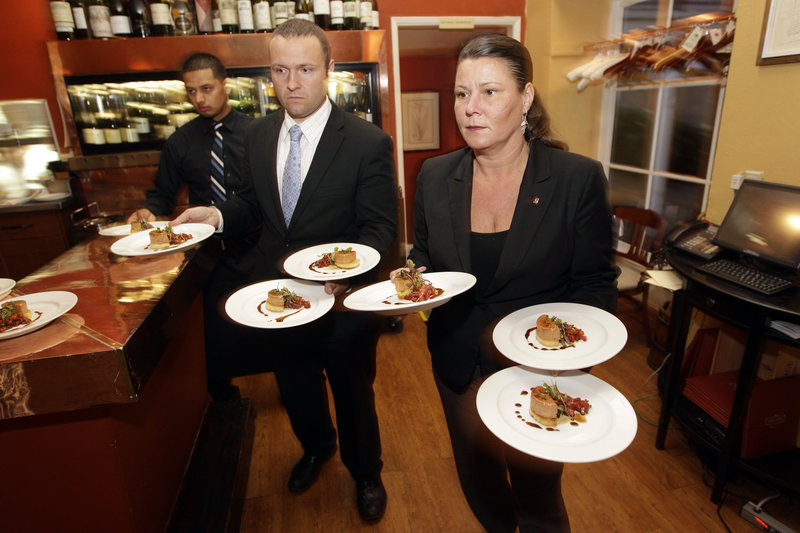This is not a good time to be a duck with a fatty liver in California, though better times are just ahead.
Chefs are loading their high-end menus with duck liver: Terrine de foie gras, seared foie gras with mango chutney, foie gras salad and sweet foie gras for dessert. And they are keeping secret the locations of their multi-course dinners to avoid protesters as a July 1 ban looms in California, the only state to outlaw foie gras.
Demand for the delicacy created by force-feeding ducks through funnel-like tubes has never been higher, as diners sate their palates with a product that soon will be banned for production and sale in the Golden State.
“The price has doubled. People are finding it hard to get it because the demand is so high,” said Tracy Lee of the San Jose-based traveling dining service Dishcrawl, which has organized a series of 15 secret, sold-out foie gras dinners. Her last one is Thursday.
“We have had steady growth in demand … with a significant increase in sales in the month of May,” said Guillermo Gonzalez of Sonoma Artisan Foie Gras, the state’s only producer. He said some buyers are new customers who, because of the publicity, want to try it for the first time.
While gourmands stockpile foie gras at $60 a pound, others are stomaching the frenetic food fest with disdain.
“High-end foodies and chefs stuffing down their throats excessive amounts of fatty liver from force-fed ducks in the run-up to the ban paint a pretty ironic picture,” said Jennifer Fearing of the Humane Society of the United States.
As the California foie gras feeding frenzy escalates, protesters in San Francisco and Los Angeles are staking out restaurants and even making reservations to tie up seats at dinners they’ll never attend.
“Many people don’t know what foie gras is or how it’s produced, and they’re horrified when we tell them,” said Dana Portnoy, who shot undercover video inside a foie gras operation and organizes the San Francisco-area protests. “Occasionally we’ll run into antagonistic patrons, but that’s usually when we’re protesting at the foie gras benefit dinners.”
It’s why Lee doesn’t publicize the restaurants where her dinners will be held until a day before the date. “So far we haven’t had any protesters, which has been nice,” she said.
When it voted in 2004 to ban producing and selling foie gras, the California Legislature gave Sonoma Artisan Foie Gras more than seven years to come up with a cruelty-free way to fatten a duck’s liver Absent that, a coalition of chefs have mounted a lobbying campaign to try to overturn the law in the future, and the foie gras dinners are funding that ongoing effort.
To the oohs and aaahs of about 30 diners, Chef Josiah Slone hosted a recent seven-course foie gras feast at his Sent Sovi restaurant in Saratoga. He started with arugula with foie gras vinaigrette then moved to foie gras mousse with tartufata and English peas and seared foie gras with savory rhubarb pie. For dessert: foie, peanut butter and chocolate.
“For me, it was more of an educational dinner to talk a little about … the science behind how it’s produced,” Slone said.
There are enough quality ingredients out there that his California-French menu won’t be lacking when foie gras is gone, Slone said. As someone who goes to extreme measures to source quality meat and vegetables, he thinks animal welfare advocates could end more suffering if they’d focus on practices at large confined animal farming operations producing beef, chicken and pork.
“I think the issue that the animal rights people have is a lot bigger than foie gras,” Slone said. “Foie gras was sort of an easy target, sort of low-hanging fruit.”
Send questions/comments to the editors.



Success. Please wait for the page to reload. If the page does not reload within 5 seconds, please refresh the page.
Enter your email and password to access comments.
Hi, to comment on stories you must . This profile is in addition to your subscription and website login.
Already have a commenting profile? .
Invalid username/password.
Please check your email to confirm and complete your registration.
Only subscribers are eligible to post comments. Please subscribe or login first for digital access. Here’s why.
Use the form below to reset your password. When you've submitted your account email, we will send an email with a reset code.